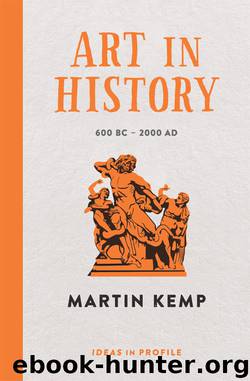Art in History, 600 BC--2000 AD by Martin Kemp

Author:Martin Kemp
Language: eng
Format: epub
Tags: Art in Histroy: 600 BC – AD
ISBN: 9781782831020
Publisher: Profile Books
Published: 2014-12-02T16:00:00+00:00
Delacroix, Death of Sardanapalusi, 1827
No one could miss the challenge that the Sardanapalus posed to academic values. The painter and writer, Étienne-Jean Delécluze, who had studied with David, summarised the standard complaints.
M. Delacroix’s Sardanapalus found favour neither with the public nor with the artists. One tried in vain to get at the thoughts entertained by the painter in composing his work; the intelligence of the viewer could not penetrate the subject, the elements of which are isolated, where the eye cannot find its way within the confusion of lines and colours, where the first rules of art seem to have been deliberately violated. Sardanapalus is a mistake on the part of the painter.
At that stage it would have been difficult to forecast that Delacroix would become the official muralist of public buildings in Paris from the 1830s onwards. Ingres, while Delacroix was exploiting his painterly facility to create colourful narratives of Orpheus and Attila the Hun on the vaulted ceiling of the library in the Palais-Bourbon, was plotting the meticulous linear arabesques in his Odalisque. In person, the urbane sophistication and open intelligence of the mature Delacroix proved more amenable to the authorities than the crabby dogmatism and strangeness of Ingres. However, they both had a great deal to say to the future.
Communion between the soul of the artist and the spectator lay at the heart of German Romanticism but with a far greater emphasis upon spiritual metaphysics. This is particularly true of its two greatest painters, Philipp Otto Runge and Caspar David Friedrich. The tone was set in the late eighteenth century by Wilhelm Wackenroder’s Effusions from the Heart of an Art-loving Monk, compiled in 1797 by the poet Johann Ludwig Tieck. The spirit is profoundly pious and looks back consciously to the Middle Ages. Everything flows from and to God, and art serves as a mirror of divine omnipotence.
Art may be called the flower of human feeling. It raises itself to the heavens from the most diverse regions of the earth in ever-changing forms … In each work of art from every region of the earth, He perceives the traces of divine spark, which having issued from Him to penetrate the breasts of humankind, passes into their small creations.
How this vision could translate into an actual painting is shown in Runge’s Morning in 1808, a small version of the large painting that he decreed should be cut into sections after his death. It was part of an ambitious project to create four major paintings of the ‘Times of Day’. Runge completed a set of much admired prints, but of the paintings only Dawn was to be realised before his death at the age of 33. The radiant dawn of Aurora is heralded by Venus, the morning star. Vibrant life is infused into the slumbering earth. Joyous angelic babes, some winged and some un-winged, greet the tiny entranced infant, who is presented with rosebuds. The central window, glowing like stained glass, is surrounded by genii and angels entwined with flowering amaryllis.
Download
This site does not store any files on its server. We only index and link to content provided by other sites. Please contact the content providers to delete copyright contents if any and email us, we'll remove relevant links or contents immediately.
Periodization Training for Sports by Tudor Bompa(8102)
The Body: A Guide for Occupants by Bill Bryson(4893)
The MacArthur Bible Commentary by John MacArthur(4688)
The Sports Rules Book by Human Kinetics(4221)
What It Really Takes to Get Into Ivy League and Other Highly Selective Colleges by Hughes Chuck(3649)
Marijuana Grower's Handbook by Ed Rosenthal(3591)
The Sprouting Book by Ann Wigmore(3516)
The Martian by Andy Weir(3255)
Salt, Fat, Acid, Heat: Mastering the Elements of Good Cooking by Nosrat Samin(3083)
The Bread Bible by Rose Levy Beranbaum(2975)
Sapiens and Homo Deus by Yuval Noah Harari(2949)
Harry Potter 4 - Harry Potter and The Goblet of Fire by J.K.Rowling(2949)
Classic by Mary Berry(2921)
The Marketing Plan Handbook: Develop Big-Picture Marketing Plans for Pennies on the Dollar by Robert W. Bly(2908)
Martha Stewart's Baking Handbook by Martha Stewart(2754)
The Plant Paradox by Dr. Steven R. Gundry M.D(2518)
Screenplay: The Foundations of Screenwriting by Syd Field(2512)
50 Economics Classics by Tom Butler-Bowdon(2489)
The Cambridge Grammar Of The English Language by Rodney Huddleston Geoffrey K. Pullum(2360)
